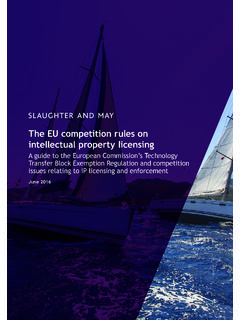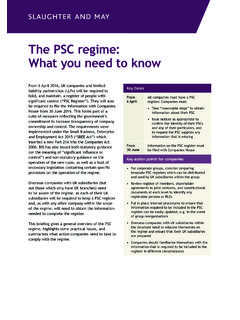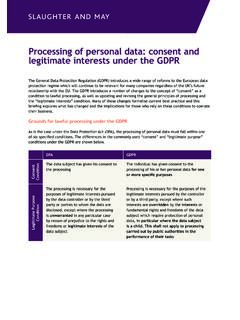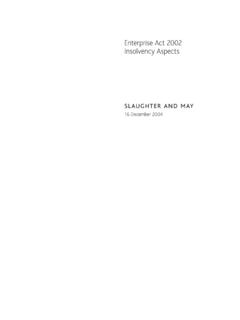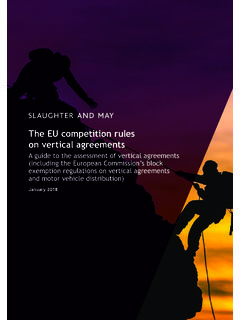Transcription of October 2016 - Slaughter and May
1 The Law of Difficult MeetingsOctober 2016 ContentsPagePART 1 - introductory purpose of this paper5 PART 2- PREPARATIONS FOR time, date and location of the at meetings: power to for class meetings11 PART 3 COMMENCEMENT AND CONDUCT OF of the s duties and powers at the meeting and handling of the can speak? and of and the length of the meeting21 PART 4 - to special resolutions or ordinary resolutions proposed at the request of to ordinary a resolution to appoint some practical giving instructions to the of no confidence28 PART 5 VOTING 6 PROXIES AND CORPORATE representatives35 PART 7 the meeting354 THE LAW OF DIFFICULT MEETINGS5 PART 1 - introductory remarksOutside the criminal law there can be few better examples of complex rules struggling to govern those who do not
2 Wish particularly to be ruled than those applying to difficult or hostile company meetings. However, unlike the situation with respect to criminal law, where rule-breakers seek to avoid the application of rules to themselves, the hostile faction at a company meeting may not be wholly or at all rule-breaking, but indeed rule-exploiting in order to frustrate, subvert or change the meeting s is a key principle of the UK Corporate Governance Code (the Corporate Governance Code ) that [t]he Board should use general meetings to communicate with investors and to encourage their participation.
3 The Institute of Chartered Secretaries and Administrators ( ICSA ) interprets this to mean that the Chairman of a general meeting must be prepared to allow debate and questions the general meeting is an opportunity for shareholders to speak, not simply a forum for the Board to deliver speeches or prepared answers to previously submitted questions. Therefore the task of the company (assuming that it is the AGM or any similar such meeting convened by the Board) and more specifically the Chairman of the meeting and his or her advisers is broadly twofold.
4 To maintain order and discipline while driving the meeting forward at a reasonable pace, and to anticipate and respond to lawful devices employed against the company s a difficult or hostile meeting, the test for the Chairman is how well he can achieve these aims without impinging on the legitimate interests of shareholders and the principle of the Corporate Governance Code referred to purpose of this paperThe present discussion must necessarily be selective, because there is a vast corpus of law concerning company meetings (unsurprisingly, battles fought at meetings are sometimes continued in the courts) and a critical element in the legal analysis is the articles of the company concerned.
5 It is possible with well-drawn articles to remove much (but not all) legal uncertainty from some areas and to tip the balance of power at meetings very much in the direction of the Chairman of the meeting. However, different companies have different views and traditions and it is not particularly useful to generalise (although it is always very important for the directors to know and understand the provisions of their company s articles).6 This discussion will concentrate on law and practice at the meeting itself.
6 It assumes that the resolutions and notice of meeting have been correctly formulated and given, that any necessary explanatory circular is satisfactorily complete and accurate and that there has been no trouble with record dates, proxy cards or disputes about 1- PREPARATIONS FOR time, date and location of the meetingThe directors usually have discretion to fix the place, time and date of the meeting. As with other powers vested in the directors, this should be exercised in good faith and in the interests of the company.
7 Consequently, the time and place of a general meeting should be arranged to be reasonably convenient to shareholders. In Cannon v Trask (1875) 20 , the directors of a company were restrained from convening an AGM on a date intentionally chosen to prevent certain shareholders from exercising their voting rights. However, Martin v Walker and Others(1918) 145 377 suggests that the meeting need not be held in the most convenient location for recommends that the location, date and time of an AGM should have regard to what is likely to be convenient to shareholders generally and that companies should try to avoid holding their AGMs on the same day as others in the same sector as clashes mean that shareholders with a portfolio across the sector cannot personally attend all the AGMs of the companies in which they hold shares.
8 Principle and audio-visual linksThe basic principle is that all members who wish to attend should be able to attend the meeting, and that all members who do attend must be able to see and hear the Chairman and all speakers (and must be able to be seen and heard by others). Consequently, large rooms with balconies may not make suitable venues. If, as at Westminster Hall, the balcony overhangs the lower seating area, it may not be possible for those on the floor and on the balcony to be in visual contact. However, Byng v London Life(1989) 2 WLR 738 gave its blessing to audio-visual links.
9 The principle stated above can be satisfied if members are electronically in one another s presence. As a further consequence of this case, an adjournment or suspension is necessary if the audio-visual link breaks down. Provided that the audio-visual link works properly, it does not matter whether the members are in the sameroom, separate rooms or even, it seems, different locations. Nonetheless, ICSA advises that, as audio-visual links are expensive to establish and can be unreliable, a large room capable of being partitioned off may be preferable to separate overspill note that as a matter of best practice, ICSA recommends that the venue for an AGM is accessible by attendees with disabilities, including hearing of venue and postponement/cancellationIf it is necessary to change the venue after the notice of meeting has been sent out.
10 Either because the venue is likely to prove too small or (as happened with bombs in the City in the 1990s) the venue is destroyed, the proper course of action is to startthe meeting at the original venue before formally adjourning it and recommencing after a short interval at the new venue. In these circumstances, it is obviously sensible to inform members in advance, ideally in writing via post and/or email, by way of an advertisement in a national newspaper and by publishing the change of venue on the investor section of the company s website.


